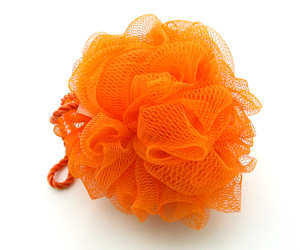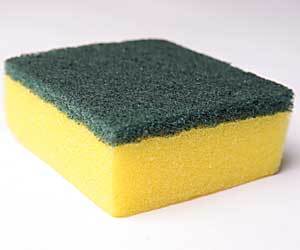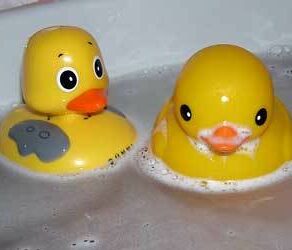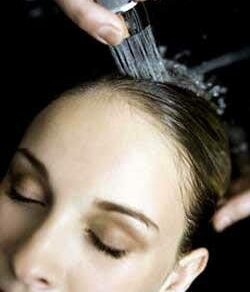Tonya asked: Do bath sponges hold bacteria? The mesh bath sponges that people buy, use and reuse to keep washing their body with. How long should you use them, and how do you clean them?
Whenever it may occur, moisture and warmth invites bacteria growth. Loofah and netted sponges are the biggest culprit. Their large holes hold onto dead skin cells, which provide food for the growing bacteria. They also hold moisture which allows the bacteria to grow. Fortunately, cleaning the sponge regularly cuts back the amount of bacteria dramatically. It’s easy to do.

You Will Need:
- Bleach
- Water
- Bucket or sink
Steps to Clean and Disinfect a Bath Sponge:
- Fill the bucket or sink with one gallon of water.
- Add ¾ cup of bleach for synthetic sponges or ¼ cup for natural sponges.
- Place the sponge into the mixture.
- Allow it to soak for at least 5 minutes.
- Remove and rinse completely with water.
- Squeeze and shake out as much of the excess water as possible.
- Allow the sponge to air dry completely.
Additional Tips and Information
- Allow your sponge to dry in a well-ventilated area each day.
- Natural sponges take longer to dry than man-made sponges. Be sure to keep them in an open area where the air can reach all areas.
- Replace your sponges regularly to keep bacteria and mold at a minimum. Replace natural sponges every 3-4 weeks and synthetic sponges about every 8 weeks.
- Avoid stuffing sponges into a hanging mesh bag or compartment on a shower caddy. They need good air flow to dry out completely.
- In addition to bacteria, mold can develop. Both of these can lead to skin rashes if not maintained.
- Many people toss their bath sponges in the laundry weekly to clean and sanitize them. Simply wash as normal with laundry detergent. Do NOT dry them in the dryer though, as the heat can melt them. Only do this in a cold water or warm water wash as well; the hot water cycle could also cause them to melt.









Yes, microwave for one min.
The cleaning information you give is just fine for SYNTHETIC Sponges/Meshes. Due to the nature of synthetics, they are unable to release germs/bacteria like a natural sea sponge. Whatever you pick up with it the first day, stays in it – unless you break out the bleach.
While bleaching is hard on any type of sponge – it will destroy a natural sponge! If it doesn’t outright dissolve it in front of your eyes, it weakens it; the decision to use bleach on a natural sea sponge must recognize that you are sacrificing the sponge – needlessly!
A natural sea sponge is superior to synthetics of any type for several reasons, two that apply here are: 1. It has greater absorbency, and, 2. It releases whatever it has picked up by simply rinsing it until the water is clear. Combine the rinse with squeezing (DO NOT WRING A NATURAL SPONGE – IT WILL RIP) to remove excess water and a good air-drying and you’re good to go.
Sometimes the sponge needs ‘freshening.’ This is achieved by soaking it in baking soda water (1 tbsp. to 1 cup). If you’re fortunate enough to have the sun, soak it for 15-30 minutes; if not, an hour soak is good. Then, simply rinse clear, squeeze well, and use or air dry for the next time.
Hand sanitizer also works well for a quick clean.
No, do not use the dishwasher on a natural sea sponge; the chemicals in the detergent will shorten it’s life.
Washing machines are very hard on natural sponges; using them will definitely shorten the life of the sponge. Friction with clothes causes ‘tags” – loosened segments that, if not trimmed, will eventually tear the sponge up.
Using chemicals (bleach, dishwasher detergents, etc.) also has a negative impact on the environment. Using any machine (clothes/dish washers) wastes energy and water.
Of course, if you’re sold on using synthetics in the first place, you aren’t environmentally friendly.
Today, most of the synthetic sponges are made of either wood pulp (cellulose), sodium sulphate crystals, hemp fibers or chemical softeners. Another common synthetic is made of polyurethane foam. These sponges may be good at cleaning, but are less ideal environmentally, as the manufacturing process relies on ozone-depleting hydrocarbons to blow the foam into shape. Also, polyurethane can omit formaldehyde and other irritants, as well as cancer-causing dioxins when incinerated! Some are treated with pesticides in order to claim ‘anti-bacterial’!
Not to mention the energy required to produce them.
I am dismayed at the cavalier attitude folks have toward ‘disposable’ sponges. Just from an economical stand point, synthetics come in packages of two or three or more – That’s because the makers know their product is headed to the garbage the second you start to use it! They are probably laughing – all the way to the bank!
Myself, I don’t have money to just throw away. I use a Key West wool for washing glassware, utensils, plates and plastic wear. Cost to me is $3.00. On average, my kitchen sponge lasts 2 months. Clean and fresh every day!
And each time I use it, I feel good knowing that I am using the ‘greenest’ product available. The environment doesn’t suffer because of my sponge choice.
And what do you use in the shower? How often do u replace it?
My son-in-law says the whole family uses the same mesh nylon scrubber. I told him that was gross. He doesn’t see anything wrong with it. What do you say?
Pat,
Just as it’s unsanitary to share a toothbrush or a bath towel, it’s unsanitary to share a bath sponge. If everyone in the family is healthy and the sponge is sanitized regularly, it’s probably not a big problem, but it increases the likelihood of spreading infections/diseases/etc. at some point down the road if one person catches something contagious, particularly since everyone in the family could use the sponge several times before the contagious person even knows their infected. Although the sponge is probably more likely to spread skin contagions, it is possible that the sponge could spread bodily fluid diseases, and if someone uses the sponge on a scuffed knee or shaving cut, the sponge is then exposed to any blood diseases as well.
Just because the sponge is often coated with soap when it’s used, does not necessarily make it more clean; most body washes do not boast of their bacteria-killing efficiency like hand soaps do, nor of their anti-fungal efficiency, etc. If you have a body wash that contains something like peppermint, eucalyptus, etc., then it is more sanitary than if you use plain soap, but that still doesn’t ensure that it will be effective against everything.
It would be best if they at least have a ‘parent’ sponge and ‘kid’ sponge, since adult & child immune systems, germ exposure levels, etc. are so different; that could help to keep the parents healthy if the kids get sick and vice versa.
Source: Women’s Day – 9 Surprising Germ Havens
Source: DC Dental Group – Sharing a Toothbrush Can Raise Risk of Disease
Source: QualityHealth – 8 Highly Contagious Skin Conditions
Source: Sustainable Baby Steps – 15 Natural, Antiviral Essential Oils
It’s not a SPONGE people! It’s a mesh rag…
The ratio of bleach to water is 1/4 TEASPOON to a gallon!! NOT 3/4 cup to a gallon!!
Arlece,
If you want to clean a sponge in the laundry with bleach, then you are correct; a weaker solution is recommended for that. We use the stronger recommended method (for disinfecting hard surfaces) here to be sure the goal of eliminating all bacteria is achieved. Many fabrics are not able to withstand the stronger solution needed to fully kill bacteria, however, bath sponges are sturdy enough that they can be treated as hard surfaces. Thanks for sharing!!
My God! I was thinking the same thing!
I have the kinds of scrubbers that are hollow to put in a bar of soap. For the synthetic, it is easy enough to take the soap out and bleach it. But what about a wool one, knitted and felted and the bar? Can I bleach that without using the soap? I don’t have a microwave, so I can’t zap it with heat. Other ideas?
Hi Joy,
Anything wool should not be bleach as the chlorine will damage it. Instead, you can either put it in the laundry or boil it in a pot to use heat. Another idea is to put the sponge in a bowl of water and drop in a denture tablet. Check out the guide How to Sanitize Laundry Without Bleach for more ideas. Good luck!